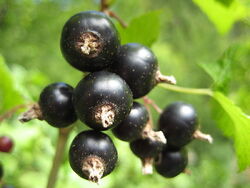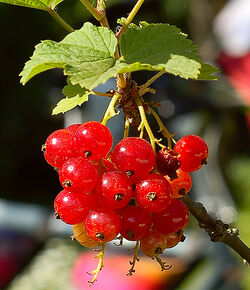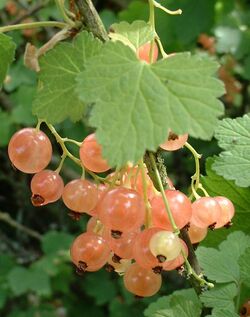About Black currants[]

Black currants
The black currant is a plant which produces safe to eat berries and it grows as a bush with leaves and stems which have a strong and not attractive smell. Black currants fruits are rich in vitamin C, have a dark purple to black color and they are similar to black grapes; their flowers have a yellow to white color; and they are available from spring to autumn. Black currants grow in woods, bottomlands and slopes. The fruits are very popular in USA, UK and in some countries from Europe. Because the fruit is very rich in vitamin C, the syrup made of black currants is recommended to be drunken by the children for its healthy benefits. Although the fruit is very sweet and taste it also has a kind a bitter taste. From black currants fruits there are made jellies, jams, juices, ice creams and liqueurs. Black currants seeds oil is much appreciated because it is a source of gamma-linoleic acid, a rare essential fatty acid. Fatty acids, which are found in black currant fruits, are implicated in many body functions such as maintaining temperature, insulating nerves, creating energy and protecting tissues.
In the UK, black currant cordial is often mixed with cider to make a drink called Cider and Black available at pubs. Adding a small amount of black currant juice to Guinness is preferred by some to heighten the taste of the popular beer. Macerated black currants are also the primary ingredient in the apéritif crème de cassis. Japan imports $3.6 million in New Zealand black currants for uses as dietary supplements, snacks, functional food products and as quick-frozen (IQF) produce for culinary production as jams, jellies or preserves. In Russia, black currant leaves may be used for flavoring tea or preserves. Sweetened vodka may also be infused with black currant leaves or berries, making a deep yellowish-green beverage with a sharp flavor and astringent taste. A universally sold drink Ribena is a juice drink made from black currants and takes its name as a pun from "Ribes".
Other than being juiced and used in jellies, syrups, and cordials, black currants are used in cooking because their astringency creates flavor in many sauces, meat dishes and desserts. It was once thought that currants needed to be "topped and tailed" (the stalk and flower-remnants removed) before cooking.
However, this is not the case, as these parts are easily assimilated during the cooking process. If one prefers, the whole black currant stem with fruit can be frozen, then shaken vigorously. The tops and tails are broken off and fruit can be separated easily.
About Red currants[]

Red currants
With maturity, the tart flavor of red currant fruit is slightly greater than its blackcurrant relative, but with approximate sweetness. The albino variant of red currant, often referred to as white currant, has the same tart flavor but with greater sweetness. Although frequently cultivated for jams and cooked preparations, much like the white currant, it is often served raw or as a simple accompaniment in salads, garnishes, or drinks when in season.
In the United Kingdom, red currant jelly is a condiment traditionally served with lamb in a sunday roast. It is essentially a jam and is made in the same way, by adding the red currants to sugar and boiling.
In France, the highly rarefied and hand-made Bar-le-duc or Lorraine jelly is a spreadable preparation traditionally made from white currants or alternatively red currants.
In Scandinavia and Schleswig Holstein, it is often used in fruit soups and summer puddings (Rødgrød, Rote Grütze or Rode Grütt); in Germany it is also used in combination with custard or meringue as a filling for tarts; in Linz, Austria, it is the most commonly used filling for the Linzer torte. Unlike the cranberry, it certainly can be enjoyed in its fresh state and without the addition of sugar.
In German-speaking areas, syrup or nectar derived from the red currant is added to soda water and enjoyed as a refreshing drink named Johannisbeerenschorle. So named because the red currant (Johannisbeeren in German) are said to first ripen on Johannistag or June 24.
About White currants[]

White currant
White currant is a berry, much like a small grape, native to France and northern Europe that is related to the gooseberry. Currant berries grow in cool regions amongst abundant moisture, growing as black, red, and white varieties. They are a juicy berry with a sweet to tart flavor. The white currant is the sweetest of all three varieties (white, red and black currants), providing a juicy sweet flavor for a variety of foods. The berries of the white currant are most often used for desserts, summer salads and soups, succulent sauces for poultry or pork, sweet or tart jams or sorbets, and eaten fresh, out of hand, since they have a sweeter taste.
White currants are rarely specified in savory cooking recipes compared to their red counterparts. They are often served raw and provide a sweetly tart flavor. White currant preserves, jellies, wines and syrups are also marketed. In particular, white currants are the classic ingredient in the highly rarefied Bar-le-duc or Lorraine jelly although preparations made of red currants can also be found.